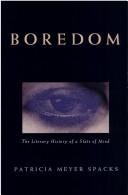Check nearby libraries
Buy this book

As malady or inspiration, boredom looms large in our culture. Forever egging the writer on to new feats of interest, new forms of poetry, new, more engrossing ideas and creations, boredom both haunts and motivates the literary imagination. This book offers a witty literary explanation of why this should be. Investigating boredom's imaginative functions during the last two and a half centuries, Patricia Meyer Spacks reveals the shifting cultural purposes served by this often lamented state.
The figure of the "bore" entered the language in the eighteenth century, marking, Spacks suggests, a significant cultural shift. Until then boredom, though not explicitly classified as a sin, was to be strenuously resisted by spiritual endeavor. With the coming of the "bore," however, the responsibility for boredom shifted from the bored observer to whatever failed to hold his or her interest. Progress should banish boredom by making life more stimulating.
What such a move meant, in society as well as literature, becomes clear in the astonishing range of fiction, poetry, conduct books, letters, and historical and sociological documents Spacks surveys. Here we see how the idea of boredom - as a point of reference or focus of opposition, as a means of characterization, repudiation, or definition, as social indictment or personal grievance - condenses a wide range of crucial meanings and attitudes.
From the gendering of boredom (how women's lives came to embody both the threat of boredom and its overthrow) to canon issues (how "boring" becomes "interesting" with a sympathetic reader), the implications of the subject steadily enlarge.
Check nearby libraries
Buy this book

Previews available in: English
Showing 1 featured edition. View all 1 editions?
| Edition | Availability |
|---|---|
|
1
Boredom: the literary history of a state of mind
1995, University of Chicago Press
in English
0226768538 9780226768533
|
aaaa
Libraries near you:
WorldCat
|
Book Details
Edition Notes
Includes bibliographical references (p. 273-280) and index.
Classifications
The Physical Object
ID Numbers
Community Reviews (0)
Feedback?| July 15, 2024 | Edited by MARC Bot | import existing book |
| August 26, 2020 | Edited by ImportBot | import existing book |
| February 13, 2020 | Edited by MARC Bot | remove fake subjects |
| July 21, 2017 | Edited by Mek | adding subject: In library |
| December 9, 2009 | Created by WorkBot | add works page |











